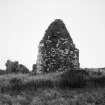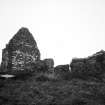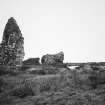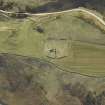Old Cambus, St Helen's Church
Churchyard (Early Medieval), Cross Slab (Early Medieval), Hogback Stone(S) (Early Medieval)
Site Name Old Cambus, St Helen's Church
Classification Churchyard (Early Medieval), Cross Slab (Early Medieval), Hogback Stone(S) (Early Medieval)
Canmore ID 59949
Site Number NT87SW 1.01
NGR NT 80368 70654
Datum OSGB36 - NGR
Permalink http://canmore.org.uk/site/59949
- Council Scottish Borders, The
- Parish Cockburnspath
- Former Region Borders
- Former District Berwickshire
- Former County Berwickshire
St Helen’s Church 2, Old Cambus, Berwickshire, hogback gravestone
Measurements: L 1.50m, H 0.28m, W 0.32m-0.37m
Stone type: sandstone
Place of discovery: NT 80377067
Present location:
Evidence for discovery: seen in churchyard in 1908. Recorded by Lang in early 1970s in churchyard near east gable of church. Not seen in 2015 but site deep in vegetation.
Present condition: very worn and the west end is damaged.
Description:
This hogback belongs to Lang’s Illustrative type. It has a flat ridge and a basal vertical plinth. Side A is divided into three panels, each carved in relief with a quadruped, two separated by a stylised tree. Side B is carved with three rows of tegulae.
Date: eleventh century.
Desk-based information compiled by A Ritchie 2016
St Helen’s Church 3, Old Cambus, Berwickshire, hogback gravestone
Measurements: L 0.64m, H 0.23m-0.27m, W 0.41m
Stone type: sandstone
Place of discovery: NT 80377067
Present location:
Evidence for discovery: seen in churchyard in 1908. Recorded by Lang in early 1970s outside the south wall of the chancel. Not seen in 2015 but site deep in vegetation.
Present condition: worn and damaged.
Description:
This hogback belongs to Lang’s Illustrative type. It has a flat ridge and a basal vertical plinth. Side A is carved in relief with a quadruped. Side B is carved with four rows of tegulae.
Date: eleventh century.
Desk-based information compiled by A Ritchie 2016
NT87SW 1.01 80368 70654
A complete hogbacked stone and a fragment of another, both of 11th century date, lie in the burial ground of St Helen's Church (NT 8037 7067). The former, of pale sandstone and measuring 149.9cm long by 30.5cm at centre lies by the E gable of the church. One side is divided into three panels, each containing a beast, while on the other, much worn, side three rows of tegulae remain. The other lies S of the chancel; it is 63.5cm long; its top is worn flat. One side shows a beast while tegulae are visible on the other. (Medieval and later monuments are also noted in the burial ground.)
J T Lang 1975; RCAHMS 1915, visited 1908; A Reid 1914; RCAHMS 1980, visited 1979.
A complete hogback stone and fragments of another, both of 11th century date apparently lie within the burial ground attached to the church. This area is not scheduled. One hogback stone is nearly covered over with turf, the other was not seen. The other 17th century burial stones lie close to the S wall of the church in a tumbled fashion, some have been moved probably recently into their present position. They are poorly displayed and require attention. Not affected by coastal erosion.
Site recorded by GUARD during the Coastal Assessment Survey for Historic Scotland, 'The Firth of Forth from Dunbar to the Coast of Fife' 25th February 1996.
Field Visit (4 November 1908)
Sculptered Stones.
(1) Some 12 feet south-south-west of the south buttress of the west gable lying east and west and almost overgrown with turf is a stone of modified hog-back type. It is 4 feet 10 inches in length, being slightly imperfect at the east end, 15 inches across the base at the west end, and 12 inches at the east end; it has a depth of 11 inches at the west end and 9 inches at the east end, and measures 5 inches across the flat top . . Along the north side are faint traces of one or two rows of scale ornament with chevrons underneath: On the south side is carved in relief a dragonesque animal, its head turned backwards and its tail curled over its back,1 foot 3 inches in length, and separated by a panel of interlaced ornament, 5 inches across, from a horse which has probably had a rider, now worn off, 1 foot 2 inches in length. Between the horse and the east end of the stone is a compartment, filled with chevron ornament, 6 inches across. The carving is much worn.
(2) Lying to the south of the chancel, at the east end of a group of table stones, is a portion of a stone similar to the last. It lies north and south, and measures 2 feet in length, 1 foot 4 inches across the base, 6 inches across the flat top, and is 10 inches deep at the point of fracture. About 5 inches below the flat top, on the west side, occur three overlapping rows of scale ornament; and on the east side, towards the north or broken end, is the indistinct figure of a four-legged animal. The ornament is much decayed.
(3) Some 10 feet south of the west end of the south wall lies a stone 4 feet 8 inches in length by 1 foot 7 inches in breadth, diminishing to 1 foot 2 inches at the foot, upon which is rudely incised the figure of a man with hand clasped across the breast and a sword or dagger at the side.
(4) Against the interior face of the west wall of the nave lies a pear-shaped slab of undressed sandstone,on which is rudely inscribed a cross, the arms of which are equal, set saltire-wise, each being formed of two converging arcs of circles (fig. 19 [SC 1173207]).
RCAHMS 1915, visited 4 November 1908.
OS Map: Ber., i. SE.


























































